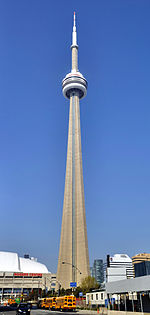Seven technological wonders of the world
| Movie | |
|---|---|
| Original title | Seven technological wonders of the world |
| Country of production | Germany |
| original language | German |
| Publishing year | 1981 |
| length | 196 minutes |
| Rod | |
| Director | Harald Reinl |
| script | Manfred Barthel |
| production | ORB Film- und TV-Produktion GmbH (Wiesbaden) on behalf of WDR (Cologne) |
Seven Wonders of the World is a seven-part German documentary film by Harald Reinl produced for television .
action
In the three-and-fifteen-hour film, technical and architectural achievements of the modern age are presented, which aim to document the progress and inventiveness of man.
1st episode: Toronto - the tallest television tower in the world
At that time the tallest structure of the present, the television tower CN Tower in Toronto, Canada has a height of exactly 553.33 meters. The construction time of the approximately 120,000 tons heavy concrete pipe was 40 months. A total of around 1500 workers were temporarily employed on the large construction site. The building was completed in 1977, and the cost was around 76 million euros. At the beginning of the 1980s, the daily number of visitors was around 10,000. In addition to the antennas for six radio and five television stations, there are restaurants, what was then the highest discotheque in the world and a so-called space platform in the CN Tower at a height of 447 meters, which offers an ideal view of the surroundings.
2nd episode: Mount Palomar - the largest reflecting telescope in the world
The observatory is located on Mount Palomar in California . Located at a good 1700 meters above sea level, the observatory had what was then the largest reflector telescope in the world. The mirror has a diameter of over five meters. It took around 30 years to cast the special glass and then grind it. Planning of the observatory began in 1924, and the telescope was put into operation 25 years later.
3. Episode: Sears Tower in Chicago - The tallest skyscraper in the world
At almost 443 meters (with antenna even almost 527 meters), the Sears Tower (today: Willis Tower) in Chicago was the tallest skyscraper in the world in 1980. Around 20,000 people found work on the 108 floors. Nine tower elements of different heights rise on a floor area of only 4624 square meters. A traffic radio station is located at a height of 400 meters above the observation deck, which has an overview of the traffic flows in the greater Chicago area and directs them with their announcements.
4th episode: The submersible Trieste II - Auguste Piccard's deep-sea diving ball
In the western Pacific is the deepest point on earth with the Mariana Trench, which is around eleven kilometers below sea level . At this point the two marine researchers Jacques Piccard , whose father Auguste Piccard had designed the predecessor submarine Trieste , and Don Walsh with a steel diving ball, the Trieste II, dived into the depths on January 23, 1960. With its depth record, the special submersible withstood the high water pressure and from then on enabled, among other things, the development of important mineral resources on the seabed.
5th episode: North Sea : The floating oil rig , the oil rig Central Platform
One of the largest oil rigs in the world at the time, the Central Platform, was located in Ninian Oild Field, UK. This platform made of iron, steel and concrete weighed around 600,000 tons and protrudes 100 meters above sea level. A total of 42 wells extend down to a depth of around 3000 meters and have been producing ten million liters of low-sulfur oil every day since the beginning of 1980, which is pumped to the Shetland Islands via an approximately 160 km long pipeline .
6th episode: The cable car from Chamonix to the Aiguille du Midi
The Aiguille du Midi ( 3842 m ) is a rocky outpost in the Mont Blanc massif south of Chamonix. A cable car leads to an altitude of over 3800 meters, the last section of which has to overcome a height difference of around 1500 meters with more than 3000 meters of rope without any support. Swiss engineers were responsible for the building design. The cable car connection, which was built between 1951 and 1954, has its starting point in Chamonix and transports 500 people an hour in 20 minutes from the valley to the mountain station. Another cable car connection leads to the Italian valley town. From there it is possible to return through the Mont Blanc tunnel to Chamonix (twelve kilometers away).
Cape Canaveral, now also known as Cape Kennedy, is NASA's US missile launch pad with an area of around 90 square kilometers. From this most famous spaceport, among other things, the space shuttle Space Shuttle launched into space . Between 1948 and the time this film was made, 42 launch ramps had been built for a wide variety of rocket types and (until 1981) over 80 astronauts had been flown into space. In 1969, Apollo 11 also started from here with Neil Armstrong on board, who was the first person to set foot on the moon .
production
Reinl's 1980/81 film, one of his rare excursions to television documentation, was broadcast on ARD on September 15, 1981 . The individual episodes were all around 28 minutes long. Horst Naumann acted as speaker from the off .




